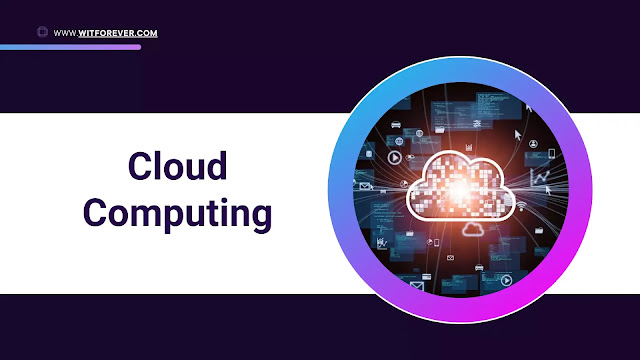Cloud computing is a means of accessing computing resources (such as servers, storage, databases, software, analytics, and information) over the Internet (“the cloud”). It provides a way to store and process data, run applications, and create and deliver content and services. Cloud computing is a general term for hosting services delivered over the Internet. It is a more efficient and cost-effective way of managing information technology (IT) resources.
Cloud computing definition
What is cloud computing?
Cloud computing is a revolutionary technology that is changing the way we work, communicate and store data. It refers to the provision of computing services over the Internet, including servers, storage, databases, software and analytics. In other words, cloud computing allows users to access these computing resources as needed without using physical infrastructure or hardware.
So Cloud computing is a means of accessing computing resources such as servers, storage, and applications over the Internet. Instead of buying and maintaining your own hardware and software, you can rent what you need from a cloud provider. This saves you money and time, and makes it easy to scale up or down IT resources as needed.
Benefits of cloud computing
There are many benefits to using cloud computing. Cloud computing offers many benefits to individuals, businesses and organizations. Some of the main advantages of cloud computing are:
1. Cost savings:
Cloud computing eliminates the need for expensive hardware and IT infrastructure, reducing capital expenditures. With a pay-as-you-go pricing model, organizations only pay for the resources they use, reducing operational costs. 2. Scalability: Cloud computing allows organizations to increase or decrease their resources according to changing needs. This means that organizations can increase resources during periods of peak usage and decrease resources during periods of slower usage without purchasing expensive hardware.
3. Accessibility:
With cloud computing, users can access their data and applications from anywhere with an Internet connection. It enables remote work and collaboration, increasing productivity and efficiency. 4. Security: Cloud providers offer strong security measures to protect data and applications, including encryption, firewalls, and threat detection. This provides an additional layer of security for organizations, especially those without a dedicated IT team.
5. Disaster Recovery:
Cloud computing provides organizations with a reliable and cost-effective disaster recovery solution. Data and applications can be backed up and stored in multiple locations, minimizing the risk of data loss or downtime in the event of a disaster. Overall, cloud computing offers businesses and organizations of all sizes a flexible, cost-effective and secure solution.
Types of cloud computing
Cloud computing can be roughly divided into three categories:
1. Infrastructure as a Service (IaaS):
This is the most basic form of cloud computing, where service providers provide virtualized computing resources such as servers, storage, and networks on a per-use basis. Customers can use these resources to build their own IT infrastructure and deploy their own applications.
2. Platform as a Service (PaaS):
This type of cloud computing provides a complete development and deployment environment in the cloud. Customers can develop, test and deploy their applications without worrying about the underlying infrastructure. Service providers are responsible for the operating system, middleware and runtime environment.
3. Software as a Service (SaaS):
This is the most advanced form of cloud computing in which service providers provide complete software applications over the Internet. Customers can access these applications through a web browser or mobile application without installing software on their devices. Vendors are responsible for everything from infrastructure to maintenance and support.
Cloud computing trends
Because of these advantages, cloud computing is becoming increasingly popular. In fact, the latest research from Gartner predicts that global spending on cloud computing will reach $395 billion by 2023. Here are some of the top cloud computing trends to watch in 2023.
Multi-cloud and hybrid cloud deployments: More and more companies are moving to multi-cloud or hybrid cloud deployment models. This means they use multiple cloud providers or a combination of cloud and on-premises resources. This trend is driven by the need for flexibility and agility.
Serverless Computing: Serverless computing is a cloud computing model where the cloud computing service provider takes care of all server management tasks such as server provisioning, scaling and management. This allows companies to focus on developing and running their applications.
Artificial Intelligence (AI) and Machine Learning (ML): AI and ML are becoming increasingly important in cloud computing. Cloud providers offer a variety of AI and machine learning services, such as natural language processing, image recognition, and machine learning. These services help businesses automate tasks, improve decision-making, and gain insights from data.
Edge Computing: Edge computing is a distributed computing model that brings computing resources closer to end users. This can improve performance and reduce latency for applications that require real-time processing.
Blockchain: Blockchain is a distributed ledger technology that can be used to create secure and transparent transactions. Cloud service providers offer blockchain services such as blockchain-as-a-service (BaaS) that can help companies develop and deploy blockchain applications.
These are just a few of the top cloud computing trends to watch for in 2023. Cloud computing is a fast-moving field with new trends emerging all the time. Companies that want to stay ahead of the curve need to keep up with these trends and ensure that their cloud strategy aligns with their business goals.
Conclusion
Cloud computing is a powerful technology that can help businesses of all sizes save money, increase efficiency and innovate faster. If you’re considering moving to the cloud, be sure to do your research and choose a service provider that fits your needs.
